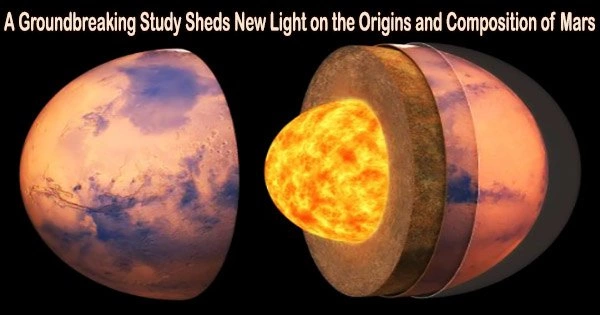A new study has revealed fascinating insights into the liquid core at the heart of Mars, adding to our understanding of the planet’s genesis and development.
The study, led by the University of Bristol and published in the journal Proceedings of the National Academy of Sciences in the United States, reveals the first detections of sound waves traveling into Mars’ core.
Measurements of this acoustic energy, known as seismic waves, show that its liquid core is slightly denser and smaller than previously assumed, and is made up of iron and a variety of other elements.
The discoveries are all the more astounding given that the research mission was only supposed to last a little more than one Mars year (two Earth years). Despite Martian storms hastening the accumulation of dust and reducing power to the NASA InSight Mars lander, NASA extended its stay, so geophysical data, including signals of marsquakes, continued to be gathered until the end of last year.
Lead author Dr. Jessica Irving, Senior Lecturer in Earth Sciences at the University of Bristol, said: “The extra mission time certainly paid off. We’ve made the very first observations of seismic waves travelling through the core of Mars. Two seismic signals, one from a very distant marsquake and one from a meteorite impact on the far side of the planet, have allowed us to probe the Martian core with seismic waves. We’ve effectively been listening for energy travelling through the heart of another planet, and now we’ve heard it.”
“These first measurements of the elastic properties of Mars’ core have helped us investigate its composition. Rather than being just a ball of iron, it also contains a large amount of sulfur, as well as other elements including a small amount of hydrogen.”
The new results are important for understanding how Mars’ formation and evolution differ from those of Earth. New theories about the formation conditions and building blocks of the red planet will need to be able to match the core’s physical properties as revealed by this new study.
Dr. Jessica Irving
The researchers utilized data from NASA’s InSight lander, a robotic mission built to explore Mars’ interior, to compare seismic waves traveling through the planet’s core with those transiting Mars’ shallower areas, and to predict the planet’s internal features.
The InSight lander deployed a broadband seismometer on the Martian surface in 2018, allowing for the detection of seismic events, including marsquakes and meteorite impacts. Seismologists, geodynamicists, and mineral physicists used observations of two seismic events in the opposite hemisphere from the seismometer to calculate the travel times of seismic waves that passed through the core versus seismic waves that remained in the mantle.
Dr. Irving said: “So-called ‘farside’ events, meaning those on the opposite side of the planet to InSight, are intrinsically harder to detect because a great deal of energy is lost or diverted away as waves travel through the planet. We needed both luck and skill to find, and then use, these events. We detected no farside events in the first Martian year of operations. If the mission had ended then, this research couldn’t have happened.”
“The sol 976 marsquake was the most distant event found during the mission. The second farside event, S1000a the first event detected on day 1,000 of operations was particularly useful because it turned out to be a meteorite impact which we heard all the way through the planet, so we knew where the seismic signals came from. These events came after the Marsquake Service (MQS) had honed their skills on hundreds of days of Martian data; it then took a lot of seismological expertise from across the Insight Team to tease the signals out from the complex seismograms recorded by the lander.”
The authors to create models that described the physical parameters of the core, such as its size and elastic wave-speed, used these results. The findings indicate that Mars’ core is slightly denser and smaller than previously estimated, with a radius of about 1,780-1,810 kilometers. These findings are consistent with the core containing a relatively high fraction of light elements alloyed with iron, including a lot of sulfur and a little less oxygen, carbon, and hydrogen.
Co-author Ved Lekic, Associate Professor of Geology at the University of Maryland College Park, in the US, said: “Detecting and understanding waves that travel through the very core of another planet is incredibly challenging, reflecting decades of efforts by hundreds of scientists and engineers from multiple countries. We not only had to utilize sophisticated seismic analysis techniques, but also deploy knowledge of how high pressures and temperatures affect properties of metal alloys, leveraging the expertise of the InSight Team.”
Dr. Irving added: “The new results are important for understanding how Mars’ formation and evolution differ from those of Earth. New theories about the formation conditions and building blocks of the red planet will need to be able to match the core’s physical properties as revealed by this new study.”
Dr. Jessica Irving and co-author Dr. Anna Horleston, a seismologist from the University of Bristol, were supported with funding from the UK Space Agency.
















